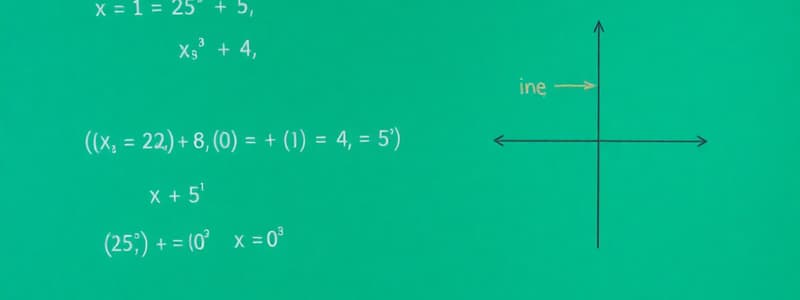Podcast
Questions and Answers
Which action necessitates reversing the inequality sign when solving?
Which action necessitates reversing the inequality sign when solving?
- Dividing both sides by a negative number. (correct)
- Subtracting a positive number from both sides.
- Adding a negative number to both sides.
- Multiplying both sides by a positive number.
What is the significance of the sign (positive or negative) of a coefficient when shading inequalities on a graph?
What is the significance of the sign (positive or negative) of a coefficient when shading inequalities on a graph?
- It determines the steepness of the line.
- It determines the direction in which to shade. (correct)
- It indicates whether the line should be solid or dashed.
- It has no impact on the direction of shading.
When graphing the inequality $y > -4$ on a coordinate plane, which of the following steps is correct?
When graphing the inequality $y > -4$ on a coordinate plane, which of the following steps is correct?
- Locate -4 on the y-axis and shade upwards. (correct)
- Locate -4 on the x-axis and shade to the left.
- Locate -4 on the x-axis and shade to the right.
- Locate -4 on the y-axis and shade downwards.
What should you remember to do when you multiply both sides of an inequality by $-1$?
What should you remember to do when you multiply both sides of an inequality by $-1$?
In the context of graphing inequalities, what does the phrase 'numbers greater than 1' typically indicate?
In the context of graphing inequalities, what does the phrase 'numbers greater than 1' typically indicate?
When graphing a linear inequality, you determine the equation of a line. What is the next critical step you must take?
When graphing a linear inequality, you determine the equation of a line. What is the next critical step you must take?
What does the process of solving linear inequalities share with solving linear equations?
What does the process of solving linear inequalities share with solving linear equations?
Why is it important to choose test points when graphing inequalities?
Why is it important to choose test points when graphing inequalities?
If the solution set to an inequality is all real numbers less than or equal to −5, how would you represent this on a number line?
If the solution set to an inequality is all real numbers less than or equal to −5, how would you represent this on a number line?
Which of the following strategies is the simplest for validating your result when graphing linear equations?
Which of the following strategies is the simplest for validating your result when graphing linear equations?
How does dividing by a negative number change the approach to solving inequalities?
How does dividing by a negative number change the approach to solving inequalities?
What is the fundamental difference between graphing $y = 3x - 4$ and graphing $y > 3x - 4$?
What is the fundamental difference between graphing $y = 3x - 4$ and graphing $y > 3x - 4$?
If you were asked to graph the inequality $y < -1$, what direction would you shade?
If you were asked to graph the inequality $y < -1$, what direction would you shade?
What does it mean if shading is done incorrectly when graphing an inequality?
What does it mean if shading is done incorrectly when graphing an inequality?
What is the purpose of calculating an inequality as if it were an equation?
What is the purpose of calculating an inequality as if it were an equation?
Given that points on a line are found to be different, what fundamental property do they share concerning linear equations?
Given that points on a line are found to be different, what fundamental property do they share concerning linear equations?
How does solving inequalities align with solving equations in general?
How does solving inequalities align with solving equations in general?
What is the first step in graphing $y < -4$?
What is the first step in graphing $y < -4$?
How do positive and negative signs affect the direction you would shade on an inequality?
How do positive and negative signs affect the direction you would shade on an inequality?
What happens when you multiply by 0?
What happens when you multiply by 0?
Flashcards
Numbers > 1 on a graph
Numbers > 1 on a graph
On a graph, numbers greater than 1 indicate an upward direction.
Numbers < -1 on a graph
Numbers < -1 on a graph
On a graph, numbers less than -1 indicate a downward direction.
Sign and shading direction
Sign and shading direction
The sign (positive or negative) in an inequality indicates the direction in which to shade the graph.
Graphing direction on y-axis
Graphing direction on y-axis
Signup and view all the flashcards
Inequality as an equation
Inequality as an equation
Signup and view all the flashcards
Dividing/multiplying by a negative
Dividing/multiplying by a negative
Signup and view all the flashcards
Choosing 0 for x and y
Choosing 0 for x and y
Signup and view all the flashcards
Study Notes
Understanding Inequalities on a Graph
- Numbers greater > 1 indicate movement upwards on the graph.
- Numbers less < -1 indicate movement downwards on the graph.
- Signs, whether negative or positive, dictate the direction in which to shade.
- Calculations are performed as if the inequality sign were an equal sign.
Shading Direction
- Incorrect shading results in an incorrect answer.
- When graphing an inequality greater than -4, locate -4 on the y-axis and then determine whether to move up or down.
- Shading direction is determined by the direction of movement (up or down).
- The signs (+ or -) indicate the direction for shading.
- Treat the inequality as an equation to determine the line.
- For example, y > 3x - 4 would initially be graphed as y = 3x - 4 to establish the boundary line.
Solving inequalities
- The inequality sign must be reversed when multiplying or dividing by a negative number.
- Sign reversal is necessary even if the result of division is positive.
Choosing variables
- Selecting 0 for x and y simplifies the process.
- Points calculated for graphing will align on the same line.
- Even with disparate points, the resulting line will remain consistent.
Studying That Suits You
Use AI to generate personalized quizzes and flashcards to suit your learning preferences.




